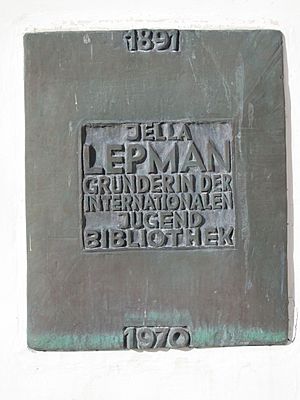Jella Lepman facts for kids
Jella Lepman (born May 15, 1891, in Stuttgart; died October 4, 1970, in Zurich) was a German journalist, writer, and translator. She is most famous for starting the amazing International Youth Library in Munich.
Her Early Life
Jella Lepman was born in Stuttgart. She was the oldest child of Josef Lehmann, a factory owner, and Flora Lauchheimer. Her family followed a type of Jewish faith. When she was 17, in 1908, she set up a special reading room for children of workers at a tobacco factory in Stuttgart. This showed her early interest in helping children access books.
In 1913, she married Gustav Horace Lepman. He was a German-American who owned a factory. They had two children, Anne-Marie and Günther. During World War I, Gustav served in the German army. He sadly passed away in 1922 because of injuries from the war. Jella was only 31 years old and a widow.
After her husband died, Jella Lepman became an editor at a newspaper called Stuttgarter Neues Tagblatt. She was the first woman to hold this important job! She wrote articles about social issues and started a special section for women. She also wrote her first children's book, The Sleeping Sunday, in 1927. She even wrote a play for children that was performed in a theater.
Jella was also interested in politics. She joined the German Democratic Party and led their women's group. In 1929, she tried to become a member of the German parliament, called the Reichstag, but she was not elected.
When the Nazis came to power in 1933, Jella Lepman lost her job at the newspaper because she was Jewish. She continued to work as a freelancer for a while. In 1936, she and her two children had to leave Germany. They moved to England. In England, she worked as a journalist and writer. She also helped organize important papers for a writer named Arthur Schnitzler. Later, she worked for the BBC and another radio station. She wrote a German children's book in 1942 and a book about women in Nazi Germany in 1943, using a different name, Katherine Thomas.
After the War
After World War II ended, Jella Lepman returned to Germany in October 1945. She worked as an advisor for the US Army. Her job was to help with programs for women and young people in the American-controlled part of Germany. This was part of a program to help Germany recover and learn new ways after the war.
In 1946, Jella organized the first international exhibition in Germany after the war. It was called the Internationale Jugendbuchausstellung, which means "International Youth Book Exhibition." This exhibition showed 2,000 books from 14 different countries. It traveled to many big cities in Germany, and over a million people visited it!
These books became the first collection for the International Youth Library. This special library opened in Munich on September 14, 1949. Jella Lepman was its director until she retired in 1957.
Jella believed that giving books to children would give them hope for the future. In 1952, she started a meeting about how children's books could help different countries understand each other better. This led to the creation of the International Board on Books for Young People (IBBY) in Zurich in 1953. IBBY is a non-profit group that promotes children's books around the world. Jella wrote more about this time in her book, A Bridge of Children's Books.
She also helped start the Hans Christian Andersen Award. This is the most important award in the world for writers and illustrators of children's books. It was first given out in 1956, and Jella was the head of the jury (the group that chooses the winner) from 1956 to 1960.
Jella Lepman wrote many children's books and collected children's stories. She even put together a multi-volume collection of bedtime stories. Her books have been translated into many languages. She gave her friend, the famous writer Erich Kästner, the idea for his children's book The Animals' Conference (1949).
Her Legacy
Jella Lepman passed away in 1970 in Zurich when she was 79 years old. Her grave is no longer there. However, her memory lives on! There is a street named after her in Stuttgart, and a room in Stuttgart's main library is also named in her honor. In Munich, a street and a child-care center are named after her.
Since 1991, to celebrate Jella Lepman's 100th birthday, the International Board on Books for Young People (IBBY) gives out the "Jella-Lepman Medal." This award honors people who have made a big difference in children's literature.
Books by Jella Lepman
- Der verschlafene Sonntag (The Sleeping Sunday), 1927.
- Das Geheimnis vom Kuckuckshof - Eine Detektivgeschichte aus dem Schwarzwald (The Secret of Cuckoo Farm - A Detective Story from the Black Forest), 1942.
- Wer ist Lux? Eine Detektivgeschichte für die Jugend (Who is Lux? A Detective Story for Young People), 1950.
- Die Katze mit der Brille - Die schönsten Gutenachtgeschichten (The Cat with Glasses - The Most Beautiful Bedtime Stories), Vol. 1, 1951; Vol. 2, 1959.
- Der verhaftete Papagei : die schönsten Gute Nacht Geschichten : neueste Folge (The Arrested Parrot: The Most Beautiful Bedtime Stories: Latest Edition), 1963.
- Die Kinderbuchbrücke (A Bridge of Children's Books), 1964. This book has been translated into many languages, including English, Japanese, Chinese, Korean, and Italian.
- Kinder sehen unsere Welt - Texte und Zeichnungen aus 35 Ländern (Children See Our World - Texts and Drawings from 35 Countries), 1971.
Awards and Honors
- 1957 Order of Merit of the Federal Republic of Germany
- 1960 Goethe Medal
See also
 In Spanish: Jella Lepman para niños
In Spanish: Jella Lepman para niños


